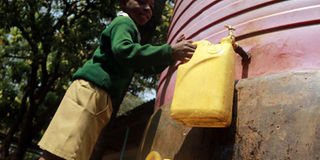Urgent, innovative ways needed to boost drinking water supply

A pupil of Pandpieri Primary School in Kisumu fetches drinking water during break time on January 2, 2018. Water harvesting is a practical and cost-effective solution to the water stress. PHOTO | TONNY OMONDI | NATION MEDIA GROUP
What you need to know:
- The water problem has reached critical stages due to rapid urbanisation and population growth.
- Kenyans need to embrace smart conservation and climate change mitigation to reduce water stress.
One of the big stories this week is about Cape Town’s water crisis and another 11 cities that are likely to run out of drinking water.
The populous city famed for its beauty and rich history could be the first major town in modern times to run out of drinking water.
The authorities are now talking about “day zero” coming on June 4, when the taps will run dry.
The situation, caused by three years of persistent drought, is so grave that the city of four million has rationed supply to 50 litres per person — equivalent to less than four minutes of showering.
WATER SHORTAGE
The other cities facing acute water shortages include Brazil’s financial capital of Sao Paulo, India’s Bangalore, Beijing, Cairo, Jakarta, Moscow, Istanbul, Mexico City, London, Tokyo and Miami in Florida, United States.
The water problem has reached critical stages due to rapid urbanisation and population growth, the impact of climate change and poor planning.
A BBC report a few days ago brought out the chilling fact that more than a billion people worldwide "lack access to water and another 2.7 billion find it scarce at least one month in a year".
The report, endorsed by the United Nations, projects that global demand for water will exceed supply by 40 per cent in 2030.
WATER TUNNEL
For Kenya, this is a wake-up call. Nairobi may not be ranked among the cities at risk of running out of water, but its residents are suffering from serious water stress, and the situation is getting worse.
Nairobi Water and Sewerage Company’s supply of 570,000 cubic metres a day falls far short of the demand of 720,000 cubic metres a day.
A more acute shortage will hit the city’s four million residents even harder.
The construction of the northern collector water tunnel was considered the panacea for the ever-thirsty region.
The controversial tunnel, which was designed to feed Thika Dam with 140,000 cubic metres of water a day from the Aberdares, has slowed down due opposition from Murang’a County’s leadership and interest groups.
The benefits envisaged when it was conceived two decades ago will take much longer to be realised.
INNOVATION
While the project presented a long-term solution to Nairobi’s water woes, it is not the only solution to the problem.
Innovative and low-cost quick fixes should be explored.
They include large-scale water harvesting, particularly in all gated residential communities and commercial developments, and exploitation of groundwater.
Harvesting is a practical and cost-effective solution.
A study by Jomo Kenyatta University of Agriculture and Technology, in collaboration with Nairobi Water Company, found that by tapping just 30 per cent of storm water, the city could meet 86 per cent of its demand.
According to the study published in July last year, the potential yield from harvesting storm water is nearly 600,000 cubic metres —as much, if not more, than the current supply.
CONSERVATION
Another solution is to increase climate-resilient initiatives to conserve water sources.
The Nature Conservancy, in partnership with Nairobi Water and other agencies, is leading in the conservation of the upper Tana River watershed to increase the supply of clean water from the sources to reservoirs.
The principle behind this “green infrastructure” initiative is that it is cheaper to arrest water problems at the source than to treat them downstream.
Although the project, which is funded through the multiagency Upper Tana-Nairobi Water fund, is more long term, it has short term interventions that can change the volume and quality of drinking water.
They include reducing sedimentation of reservoirs by teaching farmers to plant trees and grass on steep slopes to stop soil erosion, accelerating agro-forestry and increasing vegetation along river banks.
Kenyans need to embrace smart conservation and climate change mitigation to reduce water stress, even in times of prolonged drought.
Doing this will reduce the increasing risk of conflicts over drinking water.
Mr Warutere is a director of Mashariki Communications Ltd, [email protected]





